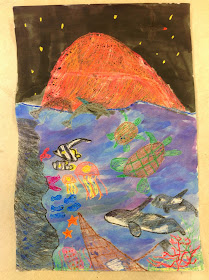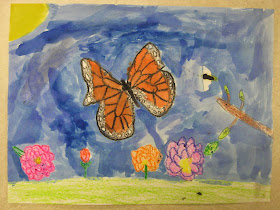I think most art teachers have a few lessons they repeat every year because they love to teach them! One of my repeat favorites is large scale (12"x18") watercolor resist paintings of undersea life based on the artist Wyland's murals. This year, I feel like my 4th graders struggled. With so many snow days earlier this year, the lessons came out disjointed, with too many days off between working on the assignment. One 4th grade class didn't even complete this assignment (my Monday class; too many Monday snow days, in addition to Monday holidays, and professional development days on Mondays).
Well, here are some results from this year. You can compare with last year and the previous year and decide for yourself how my students did this year.
Tuesday, May 27, 2014
Thursday, May 22, 2014
"Painting with Scissors" Like Matisse
I recently shared some of Henri Matisse's paintings with my 1st grade students. Then, I told them about his cancer diagnosis in 1941, after which he used a wheel chair and could no longer paint. The students thought he must have been very sad; Matisse loved to paint, and now he couldn't do it!
Then, I told the students that Matisse came up with another idea of how to make art. He began "painting with scissors" by making collages of cut paper! We looked at some of his paper cuttings, and the students noticed some very intricate shapes in his art.
Many students thought the recurring shape seen in La Gerbe looked like marine plants, like a coral reef! We used that idea to create our own collages of marine life. I'm pleased with these results! I told the students that if they needed to draw a shape before cutting, to flip the shape over after cutting so no pencil lines show in the finished art.
Then, I told the students that Matisse came up with another idea of how to make art. He began "painting with scissors" by making collages of cut paper! We looked at some of his paper cuttings, and the students noticed some very intricate shapes in his art.
Many students thought the recurring shape seen in La Gerbe looked like marine plants, like a coral reef! We used that idea to create our own collages of marine life. I'm pleased with these results! I told the students that if they needed to draw a shape before cutting, to flip the shape over after cutting so no pencil lines show in the finished art.
Wednesday, May 21, 2014
A Short Animation
Today, I shared this amusing animated film with my students. I think animation is a fine art form which all my students should be familiar with. I began by asking the students to think of all the jobs they could think of that an artist could have; usually at least one student thought of animation.
This short animation is created by Birdbox Studio in London. After viewing it, the class discussed the purpose of such a film; perhaps Birdbox Studio created it for publicity. If people like it, they will share it with others! As Birdbox Studio gets more hits on their website, more companies may be interested in hiring them to create animated commercials.
As the school year is drawing to a close, this little movie was a fun addition to a few lessons. It's only a minute long; watch and enjoy! The students loved it, and kept requesting, "play it again!" "play it again!"
Monday, May 19, 2014
Kindergarten Ladybugs in the Grass
I need to start out by saying, this is not my original lesson! Like many other art teachers, I get a lot of inspiration from Pinterest. I have seen this ladybug collage floating around on Pinterest lately, and I decided to try it with my kindergartners.
This project ended up being a great lesson on perspective! The students really had to imagine themselves at eye-level with a ladybug to create this composition. We discussed the size of a ladybug, and how creating it real-life size would mean the picture would be very empty (imagine a 1/4" object on a 9"x12" paper; I drew a speck in a rectangle on my blackboard to demonstrate). Zooming in on the ladybug makes a better composition!
These last few days of school (11 left! not that I'm counting....), one kindergarten class in particular has been struggling a lot with behavior. They have been very irresponsible with paint (painting on their hands, on the table, spilling the water on purpose, etc.), so I've been switching to collage work. So far, it's been a success! I've had much fewer behavior problems related to art supply misuse. I just hope no one decides to give themselves a haircut, or alter their clothing....sometimes scissors are the worst thing for a rowdy kindergarten class.
This project ended up being a great lesson on perspective! The students really had to imagine themselves at eye-level with a ladybug to create this composition. We discussed the size of a ladybug, and how creating it real-life size would mean the picture would be very empty (imagine a 1/4" object on a 9"x12" paper; I drew a speck in a rectangle on my blackboard to demonstrate). Zooming in on the ladybug makes a better composition!
These last few days of school (11 left! not that I'm counting....), one kindergarten class in particular has been struggling a lot with behavior. They have been very irresponsible with paint (painting on their hands, on the table, spilling the water on purpose, etc.), so I've been switching to collage work. So far, it's been a success! I've had much fewer behavior problems related to art supply misuse. I just hope no one decides to give themselves a haircut, or alter their clothing....sometimes scissors are the worst thing for a rowdy kindergarten class.
Tuesday, May 13, 2014
1st Grade Monarch Butterflies
This lesson was taught as a cross between a guided drawing, and an observational drawing. I put a large photograph of a monarch on my Promethean board, and guided the students through all the necessary observations. We began with the shape of the body; it's very skinny. Then, I asked questions to help the students notice that the top wings extend way above the head. We drew the shape of the wings, and then I guided the students through observing the patterns. We drew the white spots along the edge of each wing first. Then the students drew a looped line. Lines from the loop to the edge of each wing made the rest of the pattern.
The students drew the butterfly with black crayon, and then painted the wings with orange watercolors. My educational goals for this lesson are for them to learn to notice details and be able to draw from observation on their own later on. They were asked to choose anything else they liked to draw in their picture; many drew flowers around the butterfly. They could choose to use watercolors, crayons, or both for their details. The success rate for this lesson was very high; I don't think there was a single painting in the bunch that didn't easily represent a monarch!
The students drew the butterfly with black crayon, and then painted the wings with orange watercolors. My educational goals for this lesson are for them to learn to notice details and be able to draw from observation on their own later on. They were asked to choose anything else they liked to draw in their picture; many drew flowers around the butterfly. They could choose to use watercolors, crayons, or both for their details. The success rate for this lesson was very high; I don't think there was a single painting in the bunch that didn't easily represent a monarch!

























































